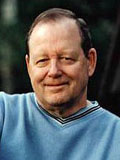Robert Taylor

Throughout his career, Bob Taylor ran some of the most important projects in the development of networking and personal computing. After working as an engineer for several aircraft and defense companies, he joined NASA’s Office of Advanced Research and Technology as a project manager in 1962. That same year Taylor met J. C. R. Licklider who, like Taylor, had done graduate work in psychoacoustics. Licklider’s vision of computing would influence much of Taylor’s work and together they helped chart a course for the future of computing. In a paper they co-published in ’68, they predicted what few could see at the time: “The programmed digital computer…can change the nature and value of communication even more profoundly than did the printing press and the picture tube.”
In 1965 Taylor went to work at the Defense Department’s Advanced Research Projects Agency (ARPA) and the next year took over as director of ARPA’s Information Processing Techniques Office (IPTO). In his office he had 3 terminals that each connected him to a different time sharing system under ARPA’s sponsorship. The fact that these systems couldn’t connect to each other gave him the inspiration to envision a system where users in one system could communicate with anyone connected to the system. With this goal in mind, he approached ARPA’s director, Charles Herzfeld, who liked the idea and immediately gave him funding to pursue what would eventually become the Arpanet project. Taylor attempted to recruit Larry Roberts to head the project. Despite Roberts’ repeated refusals to re-locate to the D.C. area, Taylor’s dogged persistence, including an appeal to Roberts’ boss at Lincoln Labs, won out and Roberts finally accepted the position. In Taylor’s words, he was able to “blackmail him into fame”.
After leaving IPTO he taught briefly at the University of Utah. He then joined Xerox’s Palo Alto Research Center (PARC) in 1970, to help start and run their Computer Science Laboratory. From 1970 to 1983 Taylor managed a series of influential projects at Xerox PARC including the development of Ethernet. Taylor’s success was as much due to his strength of vision as it was to his skill in managing highly talented engineers and scientists. Alan Kay, who worked with Taylor at PARC, describes Taylor’s leadership: “He created maximum synergy in the room.” Fiercely protective of his staff, Taylor kept them as isolated as possible from the meddling of management above him. When a young graduate student, Robert Metcalfe, was hired to connect PARC to the Arpanet, Taylor allowed him to take several months at the University of Hawaii to collect data on their ALOHAnet project, in order to finish his PhD thesis. The data Metcalfe gathered in Hawaii proved helpful in the ultimate design of Ethernet.
In 1983, Taylor left Xerox PARC to join Digital Equipment Corp. (DEC) where he started the Systems Research Center (SRC). I met Taylor at the research center for this interview. Unfortunately, our meeting was cut short by the arrival of unexpected guests.
Keywords: ARPA, IPTO, Arpanet, Xerox PARC, DEC, SRC, Ethernet, Networking